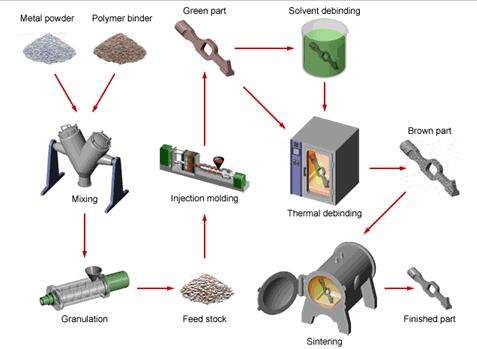The injection molding process of plastic parts mainly includes 6 stages: mold closing - filling - (gas-assisted, water-assisted) pressure-holding - cooling -Opening the mold - Demolding.

Injection molding process filling stage
Filling is the first step in the whole injection molding cycle, and the time is counted from the time the mold is closed to the time the mold cavity is filled to about 95%. Theoretically, the shorter the filling time, the higher the molding efficiency; however, in actual production, the molding time is subject to many conditions.
High-speed filling. High speed filling with high shear rate, plastic due to shear thinning effect and the presence of viscosity decline, so that the overall flow resistance to reduce; local viscous heating effect will also make the thickness of the curing layer thinner. Therefore, in the flow control phase, the filling behavior often depends on the volume size to be filled. That is, in the flow control phase, the shear thinning effect of the melt is often large due to high speed filling, while the cooling effect of thin walls is not obvious, so the utility of the rate prevails.
Low-rate filling. Heat transfer controlled low speed filling has a lower shear rate, higher local viscosity and higher flow resistance. Due to the slower rate of thermoplastic replenishment, the flow is slower, so that the heat transfer effect is more pronounced, and heat is quickly taken away for the cold mold wall. Together with a relatively small amount of viscous heating phenomenon, the thickness of the curing layer is thicker, and further increase the flow resistance of the thinner part of the wall.
Injection molding process pressure-holding stage
During the holding phase, the plastic exhibits partially compressible properties due to the fairly high pressure. In the higher pressure area, the plastic is denser and has higher density; in the lower pressure area, the plastic is looser and has lower density, thus causing the density distribution to change with position and time. The plastic flow rate is very low during the holding process, and the flow no longer plays a dominant role; the pressure is the main factor affecting the holding process. The plastic has filled the mold cavity during the holding process, and the gradually cured melt is used as the medium for transferring pressure at this time.
In the selection of injection molding machine, you should choose the injection molding machine with large enough clamping force to prevent the phenomenon of rising mold and can effectively carry out pressure-holding.
In the new injection molding environment conditions, we need to consider some new injection molding process, such as gas-assisted molding, water-assisted molding, foam injection molding, etc.
Cooling stage of injection molding process
The molding cycle of injection molding is composed of mold closing time, filling time, holding time, cooling time and demolding time. Among them, cooling time accounts for the largest proportion, which is about 70% to 80%. Therefore, the cooling time will directly affect the length of the molding cycle and the yield of plastic products. The temperature of plastic products in the demolding stage should be cooled to a temperature lower than the heat deformation temperature of plastic products to prevent the relaxation of plastic products due to residual stress or warpage and deformation caused by external forces of demolding.
Factors that affect the cooling rate of the product are
Plastic product design aspects. Mainly the wall thickness of plastic products. The greater the thickness of the product, the longer the cooling time. Generally speaking, the cooling time is about proportional to the square of the thickness of the plastic product, or proportional to the 1.6 times of the maximum runner diameter. That is, doubling the thickness of the plastic product increases the cooling time by 4 times.
Mold material and its cooling method. Mold material, including mold core, cavity material and mold frame material, has a great influence on cooling rate. The higher the heat conduction coefficient of mold material, the better the effect of heat transfer from plastic in unit time, and the shorter the cooling time.
The way of cooling water pipe configuration. The closer the cooling water pipe is to the mold cavity, the larger the diameter of the pipe and the more the number, the better the cooling effect and the shorter the cooling time.
Coolant flow rate. The larger the flow of cooling water, the better the effect of cooling water to take away heat by thermal convection.
The nature of the coolant. The viscosity and heat transfer coefficient of the coolant will also affect the heat transfer effect of the mold. The lower the viscosity of the coolant, the higher the heat transfer coefficient, the lower the temperature, the better the cooling effect.
Plastic selection. The plastic's is a measure of how quickly the plastic conducts heat from a hot place to a cold place. The higher the thermal conductivity of the plastic, the better the thermal conductivity, or the lower the specific heat of the plastic, the easier the temperature change, so the heat can easily escape, the better the thermal conductivity, and the shorter the cooling time required.
Processing parameters setting. The higher the material temperature, the higher the mold temperature, the lower the ejection temperature, the longer the cooling time required.
Injection molding process demolding stage
Demolding is the last part of the injection molding cycle. Although the products have been cold-set, the demolding still has an important impact on the quality of the products. Improper demolding may lead to uneven force during demolding and deformation of the products when ejecting.
There are two main ways of demoulding: top bar demoulding and stripping plate demoulding. When designing the mold, we should choose the suitable demoulding method according to the structural characteristics of the product to ensure the product quality.













